
Kershaw County is a county located in the U.S. state of South Carolina. As of the 2020 census, its population was 65,403. The county seat and largest community is Camden. The county was created in 1791 from parts of Claremont, Lancaster, Fairfield, and Richland counties. It is named for Col. Joseph Kershaw (1727–1791), an early settler and American Revolutionary War patriot.

Bethesda Presbyterian Church is a historic church at 502 DeKalb Street in Camden, South Carolina. A National Historic Landmark, the main church building was built in 1822 and is one of few surviving churches designed by 19th-century American architect Robert Mills.

Mulberry Plantation, also known as the James and Mary Boykin Chesnut House is a historic plantation at 559 Sumter Highway south of Camden, South Carolina. Declared a National Historic Landmark in 2000, it is significant as the home of American Civil War chronicler Mary Boykin Chesnut, who produced some of the most important written accounts of the war from a Confederate perspective. The main house, built about 1820, is a fine example of Federal period architecture.
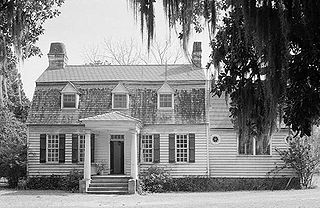
The Oakland Plantation House which is also known as Youghall or Youghal Plantation House, was built about 1750 in Charleston County, South Carolina about 7 mi (11 km) east of Mount Pleasant. It is located about 1 mile (1.6 km) south of U.S. Route 17 on Stratton Place. It was named to the National Register of Historic Places on July 13, 1977.
McCoy House, McCoy Farmhouse, McCoy Farm or variations may refer to:
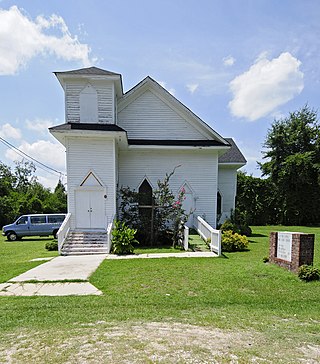
Clinton AME Zion Church is a historic African Methodist Episcopal church located on Johnson Street between Marion and Richland Streets in Kershaw, Lancaster County, South Carolina. It was built in 1909, and is a one-story, T-shaped, Gothic Revival style frame structure covered with clapboard siding and has a brick pier foundation with concrete block infill. It was the first separate black church established in Kershaw in the early 20th century.

The McCoy Farmhouse is a historic house located at 2925 Syene Road in Fitchburg, Wisconsin. The Italianate farmhouse was built in 1861 on an early Wisconsin tobacco farm. From 1949 to 1978 microbiologist Elizabeth McCoy lived there. In 1980 the house was added to the National Register of Historic Places.
The McDowell Site, also known as Chesnut Mounds, Taylor Mounds, and Mulberry Plantation House, is a set of historic mounds located near Camden, Kershaw County, South Carolina. The McDowell Site is among the first archaeological sites to be carefully excavated and archaeologically reported in the United States. It represents a widespread late prehistoric Indian culture known by the names of Lamar, Irene, and Pee Dee, and possibly extends into protohistoric and historic times. It probably dates between AD 1400 and AD 1700.
Midfield Plantation, also known as Ellerbe House and Boineau House, was a historic plantation house located near Boykin, Kershaw County, South Carolina. It was built about 1821, and was a two-story, hip roofed, frame dwelling on a high masonry basement. It had rear additions added about 1900. The original kitchen and smokehouse are still on the property as remains.

Cool Springs is a historic home located near Camden, Kershaw County, South Carolina. It was built about 1832, and is a two-story Greek Revival style house on a raise brick basement. The original house was remodeled in the 1850s. It features a tiered portico and verandahs, supported by 64 Doric order columns. A two-story kitchen addition was attached to the house about 1935. Also on the property are the contributing two horse stables, a concrete piscatory, an old stone spring, a brick basin, a dam, and granite gate posts.

Thomas English House, also known as the Murchison House, is a historic home located at Camden, Kershaw County, South Carolina. It was built about 1800, and is a two-story, five-bay, hip-roofed, frame and beaded weatherboard Federal I-house. It is set on brick piers connected by a recessed, stucco-covered, concrete block curtain wall. The front façade features a one-story, full-length, hip-roofed porch.
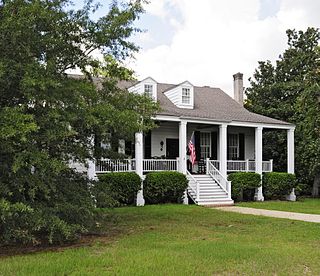
Zachariah Cantey House, also known as Buckton, is a historic home located near Camden, Kershaw County, South Carolina. It was built about 1795, and is a rectangular, 1+1⁄2-story Federal hall and parlor dwelling. It has a hewn-timber braced frame; beaded weatherboard siding; a tall, brick pier foundation and a gable roof. Zachariah Cantey was a prominent local planter, businessman, and politician.
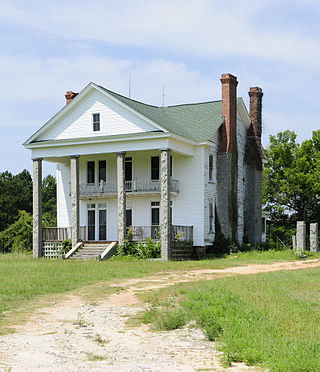
Russell-Heath House is a historic home located near Stoneboro, Kershaw County, South Carolina. It was built about 1830, and renovated about 1906. The main block is a two-story, rectangular structure with a lateral gable roof and a one-story, gable-roof wing. It has clapboard siding and a brick pier foundation. The façade has a projecting Classical Revival portico with four granite pillars. Also on the property are two contributing early-20th century, vertical plank sheds.
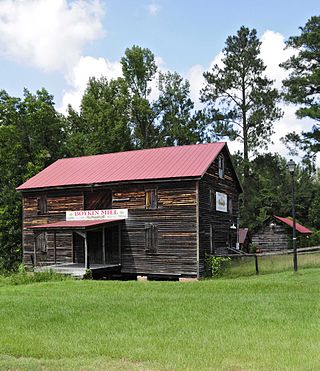
Boykin Mill Complex, also known as Mill Tract Plantation, is a national historic district located near Camden, Kershaw County, South Carolina. The district encompasses nine contributing buildings, two contributing sites, and four contributing structures. “Boykin Mill” denotes a community which consists of an old post office, an old general store, a c. 1905 grist mill, mill pond, mill dam, gates, and canals. The community also includes an early 19th-century Greek Revival style Baptist church, one mid-19th-century residence, three 20th-century residences built for mill workers, and a smoke house. An American Civil War battle site is also a part of the Boykin Mill community. The Battle of Boykin's Mill took place on April 17, 1865.

City of Camden Historic District is a national historic district located at Camden, Kershaw County, South Carolina. The district encompasses 48 contributing buildings, 8 contributing sites, 2 contributing structures, and 3 contributing objects in Camden. The district is mostly residential but also include public buildings, a church, and a cemetery. Camden's architecture is classically inspired and includes examples of Federal, Greek Revival, and Classical Revival, in addition to cottage-type, Georgian, Charleston-type with modifications, and mansion-type houses. Several of the city's buildings were designed by architect Robert Mills. Notable buildings include the Kershaw County Courthouse (1826), U.S. Post Office, Camden Opera House and Clock Tower, Camden Powder Magazine, Trinity United Methodist Church, St. Mary's Catholic Church, Gov. Fletcher House, Greenleaf Villa, The First National Bank of Camden, and the separately listed Bethesda Presbyterian Church and Kendall Mill.

Kendall Mill Historic District is a historic mill complex, mill village, and national historic district located at Camden, Kershaw County, South Carolina. The district encompasses 119 contributing buildings, 1 contributing sites, and 1 contributing structure in Camden. The district is centered on the Wateree Plant and associated structures that date from 1899 to 1923. The mill village to the south and southeast of the plant was built between 1900 and ca. 1925 and is a virtually intact reminder of the importance of the textile industry to South Carolina. The mill faces Kendall Park, a ten-acre landscaped park. On the eastern border of the park are the mill supervisors’ houses, built between 1900 and ca. 1925. The operatives house consist of one-story, 1 1/2-story, and a few two-story frame houses which date from 1900 to 1923. The district also includes Kendall Lake, north of the mill. The Dekalb Cotton Mill was organized in 1899. The Dekalb Mill building, designed by W.B. Smith Whaley in the Romanesque Revival style, was considered a model of textile architecture. The original plant building is a four-story rectangular brick building with a back stair tower and an imposing six-story front stair tower. The west addition to the plant, which is in keeping, architecturally, with the older buildings, was constructed in 1964. It is located in the City of Camden Historic District.
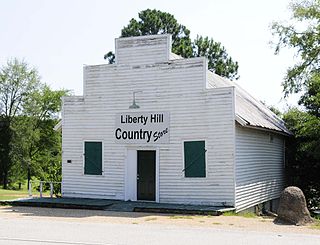
Liberty Hill Historic District is a national historic district located at Liberty Hill, Kershaw County, South Carolina. The district encompasses 34 contributing buildings and 2 contributing structures in the small rural community of Liberty Hill. The district includes several imposing Greek Revival structures, Greek Revival cottages, and an 1880s vernacular Gothic Revival church. The later, turn of the 20th century residences are primarily one-story, simple clapboard cottages. The town's history begins as early as ca. 1813 when Peter Garlick's store was a gathering place for surrounding farmers. Soon, impressive structures were built by planters in the area. Remaining from the 1830s are Cool Spring and the Joseph Cunningham House. The majority of the town's antebellum buildings, however, were built ca. 1840–1850. During this period Liberty Hill was a very wealthy community. However, the final days of the American Civil War ended that prosperity. Nevertheless, the town did eventually reassert itself and appears to have changed very little since the beginning of the 20th century.
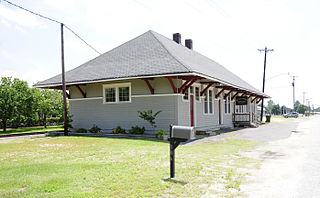
Kershaw Depot, also known as the Southern Railway Depot, is a historic train station located at Kershaw, Lancaster County, South Carolina. It was built in 1926, by the Southern Railway, and is the second or third depot built in Kershaw. The interior plan consists of a central ticketing area flanked by white and "colored" waiting areas. The Southern Railway sold the depot in 1945, and it has since been used as a florist and craft shop.

Matson Street Historic District is a national historic district located at Kershaw, Lancaster County, South Carolina. It encompasses 26 contributing buildings in a residential section of Kershaw. The majority of the buildings date from about 1890 to 1940, a particularly significant period of development in Kershaw. The houses are in a variety of representative architectural styles include Victorian, Queen Anne, Bungalow, American Craftsman, Colonial Revival, and Neo-Classical. Also located in the district is the First Presbyterian Church.

Osborne Wells House is a historic home located at Newberry, Newberry County, South Carolina. It was built about 1860, and is a brick and stucco residence consisting of a piano nobile over a raised basement. It features a projecting raised porch supported by four stuccoed brick piers. It was built by Osborne Wells, a prominent 19th century Newberry builder, planter, and brick manufacturer.



















